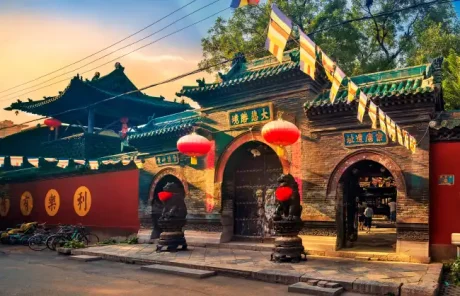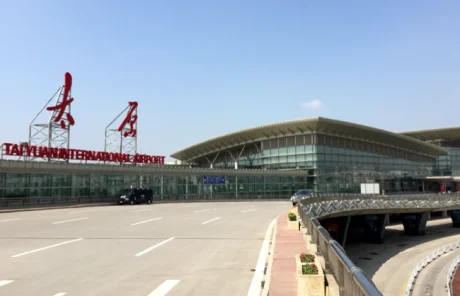Taiyuan Travel Guide – Explore a 2000-year-old Ancient Capital
Located at the point where the Fen River emerges from the mountains and opens up onto a huge plain, Taiyuan is the capital and largest city of Shanxi Province, China. Taiyuan is a famous historical and cultural city, and an ancient capital with a history of more than 2,000 years.
It is renowned as the Dragon City. Three dynasties, including the Zhao, Former Qin, North Han had Taiyuan as their capital. Another six dynasties, including North Qi, Tang, Wuzhou, Later Tang, Later Jin and Later Han had Taiyuan as the second capital.
Taiyuan City is the political, economic, cultural and international exchange centre of Shanxi Province. It is also one of the industrial hub in China, with a focus on energy and heavy chemicals. Additionally, Taiyuan is a center for scientific research and education in North China, housing numerous universities and research institutions.

Taiyuan Facts:
Chinese: 太原 tài yuán
Location: North Central Shanxi, Capital City of Shanxi Province
Population (urban area): 5,435,000
Why Visit Taiyuan
Discover Rich History and Culture
With a variety of historical and cultural sites such Twin Pagoda Temple, Jinci Temple, Yongzuo Temple, Duofu Temple, Taiyuan Confucious’ Temple, Tianlong Mountain Cave Temple, Jinyang Ancient City ruins, and Shanxi Museum, Taiyuan gives tourists an opportunity to explore Shanxi’s rich history and culture.
Taiyuan is a Major Gateway in Shanxi
As the entry point to other Shanxi destinations, Taiyuan is well-served by high-speed rail, domestic and international flights, and other transportation options. This makes it a great place to begin exploring other Shanxi tourist destinations, like Datong, Pingyao, Xinzhou (for Mount Wutai), and Linfen (for Hukou Waterfall).
Well-kept Traditions and Folklore
From generation to generation, intangible cultural heritages have been passed down, including Liuli, brick carvings, paper cutting, Jin Temple Fairs, Taiyuan Drums and Gongs, Old Chen Vinegar, and Jin Opera. Even now, handicrafts, farming, and the culture of Jin merchants are perpetuated.
Explore Different Kinds of Museums
Learn more about Taiyuan’s history and culture by visiting the Coal Museum of China, Shanxi Museum, Taiyuan Liberation Museum, Dong Shouping Art Museum, and the Museum of Geology and Mineral Resources. The Coal Museum of China and the Shanxi Museum are the best options for gaining knowledge the evolution and history of Taiyuan and Shanxi.
Taste Distinctive Taiyuan Cuisine
Noodles are the mainstay of Taiyuan cuisine. Foodies will delight in Taiyuan’s distinctive foods, featuring delicious noodles, vinegar, and preserved vegetables. Popular local foods and dishes include knife-cut noodles, Taiyuan oil pork, shaomei, cat’s ear noodles, vinegar-pepper fish, fried tofu balls, Shanxi mature vinegar, etc.
Learn about: The 15 Most Popular Chinese Dishes
Top Taiyuan Tourist Attractions
Jinci Temple
The earliest surviving royal ceremonial garden in China, Jinci Temple is the ancestral shrine of the ancient state of Jin. It is also an outstanding representative of ancient Chinese architectural art. Its coloured sculptures, murals and tablets are all national treasures.
Shanxi Museum
Shanxi Museum is the largest cultural relics collection, protection, research and exhibition centre in Shanxi. In all, there are almost 500,000 objects, the most distinctive of which are calligraphy, Buddhist statues, porcelain, stone carvings, murals, paintings, and bronze.
Twin Pagoda Temple
Yongzuo Temple, commonly known as the Twin Pagodas Temple, was built in the twenty-seventh year of the Ming Wanli calendar, four hundred years ago. It is the only temple in China that consists entirely of beamless buildings.
Tianlong Mountain Cave Temple
The Tianlongshan Grottoes have been excavated through the Eastern Wei Dynasty, Northern Qi Dynasty, Sui Dynasty, Tang Dynasty and Later Jin Dynasty for more than 400 years. It reflects the different styles of grotto art in China.
Jinyang Ancient City ruins
The ancient city of Jinyang was founded in the late Spring and Autumn period (497 BC), and has a history of more than 2,500 years. It was once the capital of Zhao during the Warring States period.
The Coal Museum of China
It serves as the collecting center for historical artifacts, specimens, records, and materials related to China's coal industry. It is the only national coal industry museum in China. Moreover, It is an institute for scientific research, science education, and coal industry PR and education.
Top Things to Do in Taiyuan
Admire the Buddhist Culture and Ancient Chinese Architecture at Jinci Temple
As early as the Zhou Dynasty, the concept of Feng Shui was formed. Feng Shui lies in adjusting the relationship between human beings and the natural environment, requiring buildings to be in harmony with all aspects of the natural environment, such as topography, geomorphology and orientation. Located at the confluence of the Hanging Jar Mountain and the Jin River, the Jin Temple is undoubtedly the best location based on Fengshui.
The layout of the Jin Temple was influenced by Confucianism, Buddhism and Taoism. It features ancient halls, pavilions, towers, springs, and trees, as well as exquisite sculptures and paintings. Don’t miss Jinci Temple when you plan a Shanxi Taiyuan tour.
Hunt Treasures from Shanxi’s Largest Museum
Over 500,000 cultural relics showcase the history and culture of Shanxi from prehistoric times to modern times. There are 40,282 pieces (groups) of precious cultural relics, including more than 110,000 ancient books. The 11 exhibition halls covers various themes such as ancient civilizations, Buddhism, traditional (Chinese) opera, folk customs, culture of Shanxi merchants, ceramics, and calligraphy.
Marvel at One of China’s Most Beautiful Twin Pagodas
Another Taiyuan landmark, the Twin Pagoda of Yongzong Temple is Taiyuan’s tallest surviving ancient structure. The two octagonal pagodas that are 53 meters high, and and decorated with glazed tiles and carvings. Both of the pagodas were built in the Ming Dynasty (1368-1644). One is the “Wenfeng Pagoda” built first, and the other is the “Stupa Pagoda” built later.
The Twin Pagoda offers a panoramic view of Taiyuan city from the top.
Explore a Variety of Ancient Sites and Temples
There are more historical and cultural heritage to see in Taiyuan. Chongshan Monastery was a Tang Dynasty (618-907) Buddhist temple, but was rebuilt in the Ming Dynasty (1368-1644).
Tianlongshan Grottoes are located 40 kilometers southwest of Jinyuan District, Taiyuan City, on the side of Tianlongshan Mountain. First chiselled in the Northern Wei Dynasty, there are 25 caves surviving today, located between the eastern and western peaks and cliffs.
Dou Daifu Ancestral Hall is a sacrificial building built to commemorate Jinchou, a scholar-official of Jin State during the Spring and Autumn period.It is also a place for the local official and civilian to pray for rain in the past generations.

Taiyuan Weather and When to Go
Taiyuan is located in the interior of the continent and has a warm temperate continental monsoon climate, with four distinct seasons.The average annual total solar radiation is 4927.90 megajoules per square metre. The total number of hours of sunshine throughout the year ranges from 2,285 to 2,587 hours. The average annual precipitation is 390~423 mm. And the average temperature ranges from 8.10°C to 11°C.
The best time to visit Taiyuan is from April to October, when you can expect mild and comfortable, beautiful scenery, spring flowers, lush greenery in summer,and autumn harvest. However, you should also be prepared for some rain in summer, especially in July and August.
If you plan to travel to Taiyuan in winter for the snow-covered landscapes, wear warm clothing. Be aware that January is the coldest month with an average low temperature of -12°C. And you can extend your Shanxi tour of Taiyuan to Pingyao Ancient City and Datong, to enjoy a unique China winter holiday.
Taiyuan Transportation
How to Get to Taiyuan
By air
Taiyuan Wusu International Airport (TYN) is located approximately 16 km (30 minutes’ drive) from Taiyuan City Center. It operates over 130 airlines connecting with more than 70 domestic and international cities, such as Beijing, Shanghai, Xian, Chengdu, Hangzhou, Urumqi, Chongqing, Kunming, Harbin, Zhangjiajie, Moscow, Sydney, etc.
By train
Travel to Taiyuan by train. Both Taiyuan Railway Station or Taiyuan South Railway Station are located in the heart of the city, and connect Beijing (2.5-3 hours), Xi’an (3-4 hours), Datong (2-3 hours), and Pingyao (40 minutes) by high-speed rail. The regular rail also connects Taiyuan with a number of other cities, including Shanghai, Guangzhou, Shenzhen, and Chengdu.
Take high-speed trains or normal trains to Taiyuan Railway Station or Taiyuan South Railway Station, both located in the city center, with high-speed trains reaching Taiyuan from cities such as Beijing (2.5-3 hours), Xi’an (3-4 hours), Datong (2-3 hours), and Pingyao (40 minutes), and normal trains from more cities such as Shanghai, Guangzhou, Shenzhen, and Chengdu.
By long-distance bus
You can take a regular bus buses to Arrive Taiyuan Long-distance Bus Station or Taiyuan Jiannan Bus Stationfrom nearby cities such as Datong, Pingyao, Shijiazhuang, and Zhengzhou.
How to Travel around Taiyuan
As of April 2024, there will be one metro in Taiyuan, the Taiyuan Metro Line 2. The theme of the decoration is ‘Dreaming of Jinyang’, inspired by the structure and colour elements of ancient Chinese architecture. There are 23 stations along the line.
Taiyuan’s bus system now operates 3,656 vehicles and 250 lines, with a route length of 4,021.23 kilometres, providing comprehensive coverage of Taiyuan’s urban areas.
For a more active way to explore Taiyuan city, use the shared bike service. You can rent a bike everywhere in the city, by using Wechat or Alipay. It usually costs 1.5 yuan for the first 30 minutes.
You can book a Shanxi tour with Taiyuan with us, with private local guide, transportation, accommodation, meals, and attraction tickets included.










